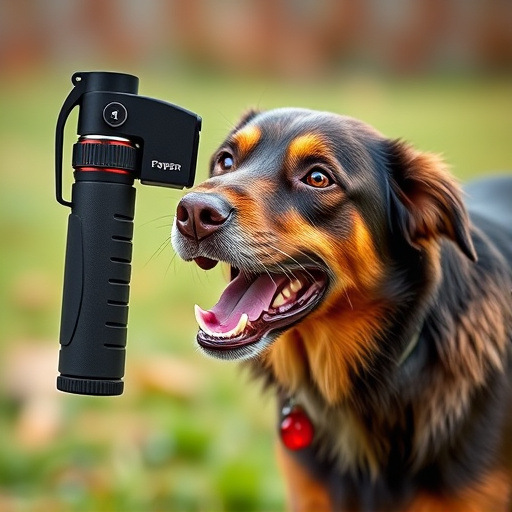Mace spray, driven by capsaicin (capsicum), effectively deters wildlife like bears and raccoons due to its burning sensation and respiratory irritation. While potency decreases post-opening, optimal storage conditions maintain performance. With a range of 3-4 meters, targeted spraying at eyes and face is crucial for maximum impact. Regular use, correct storage, and following label instructions ensure Mace spray's continued effectiveness after opening. Safety measures include reading labels, avoiding sensitive areas, using protective gear, ensuring ventilation, keeping out of reach of children and pets, and storing in cool, dry conditions away from direct sunlight.
Discover the power of compact, animal repellent pepper spray—a revolutionary tool for protecting your space. This handy device packs a punch, utilizing the well-known potency of mace spray. In this guide, we’ll explore how it works and what to expect once you open your compact spray. From understanding its active ingredients to mastering application techniques, learn essential safety precautions and storage guidelines to ensure maximum effectiveness.
- Understanding Pepper Spray: An Effective Animal Repellent
- The Science Behind Mace Spray Potency
- What to Expect After Opening Your Compact Spray
- Application Techniques for Optimal Effectiveness
- Safety Precautions and Storage Guidelines
Understanding Pepper Spray: An Effective Animal Repellent
Pepper spray, a powerful and effective animal repellent, has gained popularity for its ability to deter wildlife from homes and gardens. When it comes to understanding its effectiveness, knowing the Mace spray potency after opening is key. After a container is opened, the pepper spray begins to lose some of its initial strength due to exposure to oxygen and environmental factors. However, even with this decrease in potency, it remains a potent deterrent for most animals.
The active ingredient in pepper spray, capsaicin, is what causes the burning sensation often associated with spicy foods. In animals, it irritates their eyes, nose, and respiratory system, temporarily disorienting them and encouraging them to flee. This makes pepper spray an excellent option for those seeking a non-lethal way to protect their property from animals like bears, raccoons, and squirrels.
The Science Behind Mace Spray Potency
The effectiveness of mace spray, or pepper spray, lies in its active ingredient—capsaicin, a natural compound found in chili peppers. When sprayed, capsicum irritates the eyes and respiratory system by binding to nerve receptors, triggering a burning sensation and temporary blindness. This powerful agent is what gives mace spray its potency, making it an effective deterrent against potential threats.
The potency of mace spray remains consistent for a period after opening, ensuring its reliability in various situations. Manufacturers typically provide guidelines on shelf life and usage to ensure optimal performance. Regular users should be aware that proper storage conditions are essential to maintain the spray’s potency, especially in extreme temperatures or high humidity environments.
What to Expect After Opening Your Compact Spray
After opening your compact animal repellent pepper spray, you can expect a powerful and potent solution designed to deter unwanted wildlife encounters. The spray typically contains capsaicin, the active ingredient derived from chili peppers, which is safe for humans but highly irritant to animals. You’ll notice a fresh, slightly spicy aroma that serves as a clear signal to any potential intruders that they should steer clear.
The spray’s effectiveness lies in its concentration and range. Most compact designs offer a powerful burst of pepper spray with a reach of around 3-4 meters (10-13 feet). This allows users to protect themselves from bears, dogs, or other animals without having to carry a bulky device. Remember, proper usage involves aiming for the eyes and face, as this area is most sensitive to capsaicin, ensuring maximum deterrence with each spray.
Application Techniques for Optimal Effectiveness
When using an animal repellent pepper spray, understanding application techniques is key to maximizing its effectiveness. For optimal results, it’s recommended to apply the spray directly onto the target area, ensuring even coverage. Start at a safe distance and move closer if needed, allowing the spray to coat the animal’s fur or skin. This method helps ensure the active ingredients come into direct contact with the animal, creating a strong deterrent effect.
After opening the compact can, be mindful of the Mace spray potency as it may degrade over time. Consistent use within the recommended period will maintain its powerful formula. Regular application is crucial in areas known for animal incursions to prevent unwanted encounters. Always follow the product instructions and store the spray correctly to maintain its potency, ensuring you have a reliable defense whenever needed.
Safety Precautions and Storage Guidelines
When using an animal repellent pepper spray, such as a compact Mace Spray, safety is paramount. Always read and understand the product’s label and instructions before use. These sprays contain capsaicin, a potent ingredient derived from chili peppers, so it’s crucial to avoid contact with eyes, skin, and clothing. Wear protective gloves if applicable and ensure adequate ventilation during application. Keep the spray out of reach of children and pets, and store it in a cool, dry place away from direct sunlight. Proper storage extends the Mace Spray potency after opening, maintaining its effectiveness for longer periods.
Pepper spray, like a compact mace spray, is an effective animal repellent that leverages capsaicin to disrupt an aggressor’s sensory perception. Understanding its potency after opening and proper application techniques is crucial for optimal effectiveness. Always remember to follow safety precautions and storage guidelines to ensure its continued potency. By combining scientific knowledge with practical tips, you can use your compact mace spray responsibly and confidently.
